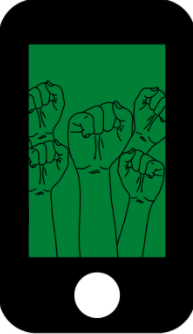
This article contains mentions of sexual violence.
As social media use becomes ever more prevalent, especially amongst the younger generation, so does online activism. Social media activism varies from reposting infographics and black squares to creating informational highlight reels for one’s profile. Although our engagement shows a promising sense of civic responsibility that social awareness is conditioned within generations, fears are raised that activism is losing its meaning and becoming a virtual performance in the same vein as a perfectly crafted selfie.
Social media is a powerful tool, especially for sharing information and education with a wide audience. But it must not replace other, “real world” forms of striving for social justice.
According to the 2020 Pew Research surveys, around one-third of social media users in total have been politically active via social media in the past month, and over half of users between ages 18 and 29 have done so. Given that 90 percent of teens and 84 percent of young adults use social media regularly, it is an effective way to get a message across to a large group of people.
Social media also has the ability to draw attention to issues that are frequently ignored by mainstream media, such as the oppression faced by Black Americans and the rates of sexual violence against women. The hashtag “BlackLivesMatter” has been shared approximately 47.8 million times between May 26 and June 7 of 2020 alone, and over half of Black Americans rate social media as an important tool for them to use their voices and connect with those with similar views.
The hashtag “MeToo”’s viral journey has also contributed to a reckoning across workplaces, schools and our culture overall, as the voices of the millions of survivors of sexual and gender based violence were heard by a wider audience than ever before. Social media is usually a place of almost completely unfettered free expression, allowing minority and oppressed groups to share views that traditional news media may shy away from. The quick and far reaching nature of the post or video gone viral also reaches a broader audience, sparking conversations throughout the world.
The problem with social media activism lies in its tendency towards virality. A post that goes viral typically stays in the public consciousness for a matter of weeks at the most. It cannot be relied upon to create a lasting change. Social media is also inherently image focused. Most people follow trends, and post in order to curate their personal persona. Mixing these attitudes with activism leads to shallow and ineffective actions.
This was evident when many posted a black square after George Floyd was murdered by Minnesota police, usually captioned “#BLM”, and were praised for their social awareness. But few actually took the time to study or share educational resources. Their moment of awareness, forever recorded on their profiles, seemed to create a sense of complacency rather than furthering their engagement with the Black Lives Matter movement.
The rates of online political engagement also do not appear to translate to offscreen activities. Voting is one of the most effective ways to make a statement of one’s values and promote a social agenda, yet voter turnout rates have been plummeting for years. Though the 2020 election saw a spike, the overall trend is still negative, especially in local elections. Rates of volunteering are also low overall, especially in the younger generation. Only around 18 percent of young adults volunteer with any organizations.
Online activism definitely has a place in the current technology dependent society. But it is imperative not to develop a sense of complacency after sharing a post to Instagram, and to remember that the work of making change cannot fully depend on the vagaries of the online world.
